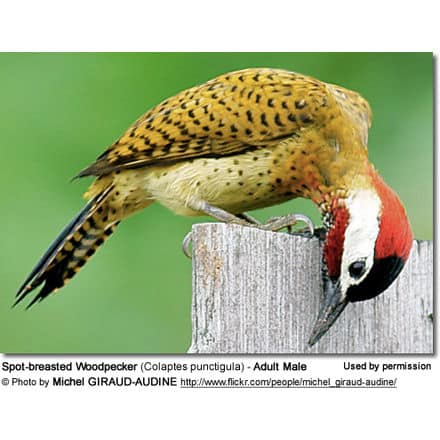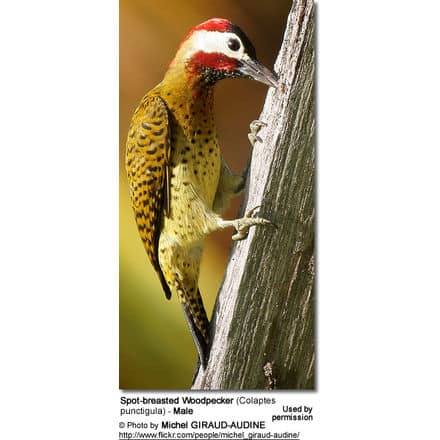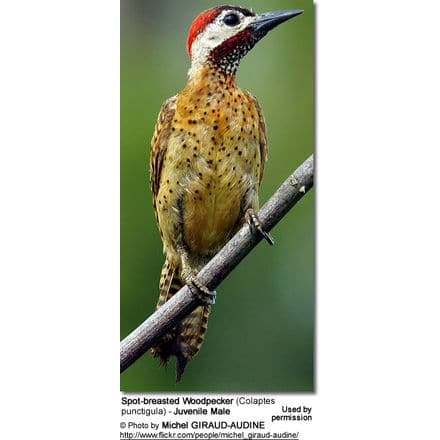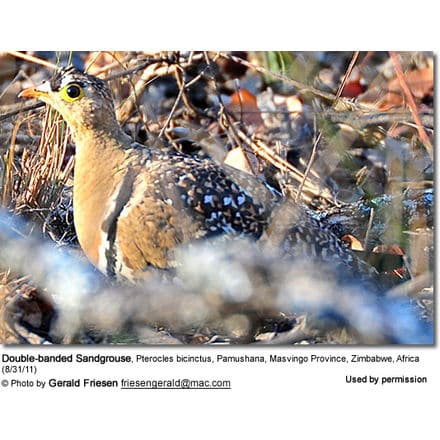Spot-breasted Woodpecker
Species account by Jeannine Miesle … Additional information added by Avianweb
Member of the Picidae Family: Woodpeckers … Sapsuckers … Flickers
Overview … Alternate (Global) Names
Distribution / Habitat … Subspecies, Ranges and ID
Description … Calls / Vocalizations
Breeding / Nesting … Diet / Feeding
The Spot-breasted Woodpeckers (Colaptes punctigula) – or Spot-breasted Flicker – is a Central and South member of the Picidae (Woodpecker) family. It is listed as being “fairly common” in its range, although the population size has not been estimated. Little is known about this species.
This sedentary bird, it has a lifespan of 4.3 years. Just as most woodpeckers, the Spot-breasted is diurnal, spending its day away from the roost. This species roosts in holes it has excavated, often drilling multiple holes in the same tree.
Deforestation has actually aided this species, since it has created less densely wood areas and clearings. The result has been an increase in the populations of several regions; this woodpecker prefers clearings and less densely wooded areas.
Distribution / Habitat
The Spot-breasted is found solely in South and Central America: Bolivia, Brazil, Colombia, Ecuador, French Guyana, Peru, Suriname, Venezuela, and Amazonia. Although there are some in eastern Panama, the populations are few and far between. Even though it is widespread, the Spot-breasted Woodpecker is not common in any of its territories.
Its natural habitats include the subtropical or tropical, moist lowland forests and mangrove forests, and heavily degraded former forests. This species also dwells in a wide variety of conditions, from very moist to dry forests, open woodlands and galleries, and riparian forests. It prefers open woodlands, not dense forests. It will inhabit artificial or terrestrial landscapes, arable land, and plantations as well as rainforests, deciduous and gallery forests, swamp edges, llanos (plains), scrub, both dry and moist savannas, and moriche palm groves. It can be found at altitudes up to 1600 meters.
Subspecies and Ranges:
Six subspecies of the Spot-breasted exist; they vary in size, degree of breast speckling and other subtle characteristics. They are:
Spot-breasted Woodpecker (Colaptes punctigula punctigula – Boddaert, 1783) – Nominate form
Found in the Guianas
Spot-breasted Woodpecker (striatigularis) (Colaptes punctigula striatigularis – Chapman, 1914)
Found in west central Colombia
Spot-breasted Woodpecker (ujhelyii) (Colaptes punctigula ujhelyii – Madarasz, 1912)
Found in eastern Panama in the eastern Darién province south to northern Colombia
Spot-breasted Woodpecker (zuliae) (Colaptes punctigula zuliae – Cory, 1915)
Found in northwestern Venezuela
Spot-breasted Woodpecker (punctipectus) (Colaptes punctigula punctipectus – Cabanis and Heine, 1863)
Found in eastern Colombia and most of Venezuela, except northwestern regions.
Spot-breasted Woodpecker (guttatus) (Colaptes punctigula guttatus – Spix, 1824)
Found in Upper Amazonia – from eastern Ecuador and eastern Peru east to northeastern Brazil in the state of Pará, south to northwestern Bolivia and northern Mato Grosso.
Description
The Spot-breasted Woodpecker averages from 18 to 21 cm. in length, and weighs 50 to 70 grams.
The Spot-breasted Woodpecker is brightly colored, bearing a slight resemblance to the Golden-olive Woodpecker (Piculus rubiginosus), which is about the same size and has a similar facial pattern. However, the Golden-Olive Woodpecker possesses band-like markings on its underparts and unbanded upperparts.
The upperparts and wings of the adult male are marked with a series of black bars.
The flight feathers are dark brown with paler bars, and yellow, narrow patches form a grouping that can be observed during flight. The rump is less marked and paler, and the central, upper tail feathers display dark brown feathers; the outer tail feathers show barred green and yellow markings.On the underparts, the plumage is a pale yellow-olive, but the upper breast is tinged reddish-orange, turning paler on the belly. The breast shows tiny black spots, and the flanks are very lightly spotted. The undertail coverts are yellowish with black spots and the undertail feathers are yellow-brown with brown bars. There are dashes of pale yellow on the underwing feathers.
The front of the crown is black, and the back of the crown, the nape and moustache are crimson. The lores and sides of the head are white, while the back and wings sport olive-colored bars. The rump is a shade of saffron with some black spots, and the bill and legs are black. The female is similar, but without the moustachial streak.
Diet / Feeding
The main staple of the Spot-breasted Woodpecker’s diet is ants; their eggs are also consumed and are found low on the tree. He will probe both trees and ground to glean them, lifting the soil and leaves to expose them. One can find this bird foraging on the ground, digging into the anthills with his mate or family.
Breeding / Nesting
Both the male and female excavate the nest cavity, choosing a dead or living tree. This is an aggressive species, and their courtship displays reflect that trait. The male erects the feathers of his crown and nape and swings both his head and body; this is accompanied by a great deal of head-bobbing, tail fanning and wing drooping.
Calls / Vocalizations / Sounds
Alternate (Global) Names
Chinese: ????? … Czech: Datel surinamský … Danish: Sortplettet Guldspætte … Dutch: Vlekborstgrondspecht … Finnish: Kultavatsatikka … French: Pic de Cayenne … German: Tüpfelbrustspecht… Guarani: Ypekû … Italian: Picchio della Cayenna, Picchio pettomacchiato … Japanese: himeshimaogera … Norwegian: Svartpannespett … Polish: dzieciol czarnoplamy … Portuguese: Pica-pau-da-várzea, Pica-pau-de-peito-pontilhado … Russian: ???????????? ?????????? ????? … Slovak: Vlikác bodkovaný … Spanish: Carpintero de Pecho Punteado, Carpintero Moteado, Carpintero Pechipunteado, Carpintero pecho manchado … Swedish: Fläckbröstad spett
Other Web Resources
Please Note: The articles or images on this page are the sole property of the authors or photographers. Please contact them directly with respect to any copyright or licensing questions. Thank you.










